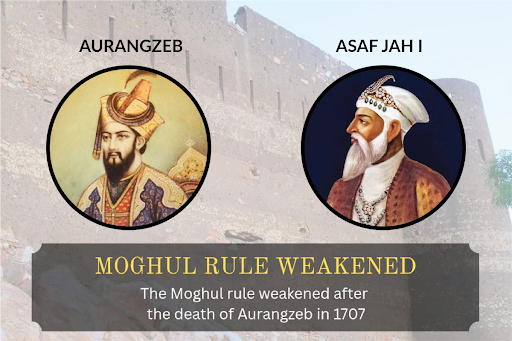
The Mughal (or Moghul) Empire began to significantly weaken after the death of Emperor Aurangzeb in 1707. He ruled for nearly 50 years (1658–1707). His Deccan campaigns drained the empire’s treasury and overstretched its military. Aurangzeb’s strict religious policies alienated large sections of the population, especially non-Muslims and regional powers.
WAR FOR SUCCESSION
As expected, a war of succession broke out among Aurangzeb’s sons. None of his successors could command authority or unify the empire. It was quite clear that there could be no development in the Deccan without, the participation of people in the region. With the central power weakening, regional governors (subedars) and nobles began asserting independence.
BREAK AWAY FROM MOGULS
Mir Qamar-ud-Din Khan served as a high-ranking noble and administrator under the Mughal emperors, especially Aurangzeb. He noticed how the Mughal Empire weakened, leading to political instability, this after Aurangzeb’s death. Mir Qamar-ud-Din Khan had a vision for developing, Hyderabad and the rest of the Deccan region.
Despite a high degree of confidence and skill in administration, acquired during his tenure with the moguls, Mir Qamar-ud-Din Khan knew that he would need to keep at least, minimum contact with the moguls – he did just that. His idea was to keep control of all administrative functions, security and finance would also be controlled by him.
ASAF JAH 1 – FIRST NIZAM
In 1724, Qamar-ud-Din Khan asserted his independence from the Mughals and established his own rule in the Deccan, founding the Asaf Jahi dynasty in Hyderabad. Should repeat here that, he continued to maintain a minimum level of contact with the Moguls. He would be called Asaf Jah 1 and also become the first Nizam of Hyderabad.
Though they maintained nominal allegiance to the Mughal emperor, the first Nizam and all Nizams to follow, ruled independently. Asaf Jah I laid the administrative and military foundations of the Hyderabad State. His governance was marked by relative stability and efficiency, helping the region prosper. The standard of living of the people improved even with, the declining central Mughal authority.
Asaf Jah I’s leadership marked the beginning of one of the most powerful princely states in India under British colonial rule. The Asaf Jahi dynasty ruled Hyderabad until 1948, when the princely state was integrated into independent India.
HYDERABAD DEVELOPMENT
While the Nizams of Hyderabad are often remembered for their immense wealth and lavish lifestyle, it’s equally important to recognize their contributions to the development of Hyderabad and the welfare of its people.
The Nizams did far more for the development of Hyderabad than the Mughals ever did. Experts on the subject mention that, the Mughals, especially under Aurangzeb, were more concerned with military campaigns and administrative control in the Deccan, rather than regional development. For the moghuls, Hyderabad was just one part of the vast Mughal Empire, and its value was mainly strategic and economic.
In contrast, the Nizams ruled Hyderabad as their own capital, and hence, they prioritized its long-term development and prosperity. Starting with the first Nizam, Asaf Jah 1 the Nizam rulers, maintained a clear differentiation between, revenue for development and revenue for the Nizam’s treasury. They invested in urban planning, education, healthcare, water supply, and transportation. Hyderabad under the Nizams became one of the most progressive princely states in India.
NOTES
References to Asaf Jah 1 have gained importance in recent times, for a different reason. Rumors published on different sources, claim that a blue diamond that was worn by Asaf Jah 1 (the first Nizam) in a lavish turban ornament, has been traced to a private collection in Europe. This diamond has not been seen for centuries, previous reports suggested that Asaf Jah 2 the second Nizam, handed over the diamond to the French in return for military protection.
The high level of interest that these rumors are gaining is expected. A blue diamond from the famed Golconda mines with a direct connection to the Nizams, is big news. With no official certifications and lack of exposure of the actual diamond, the rumors will at best be treated as fairytales for now!





